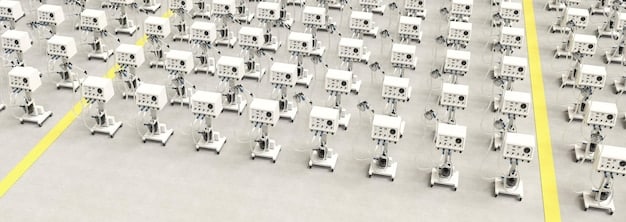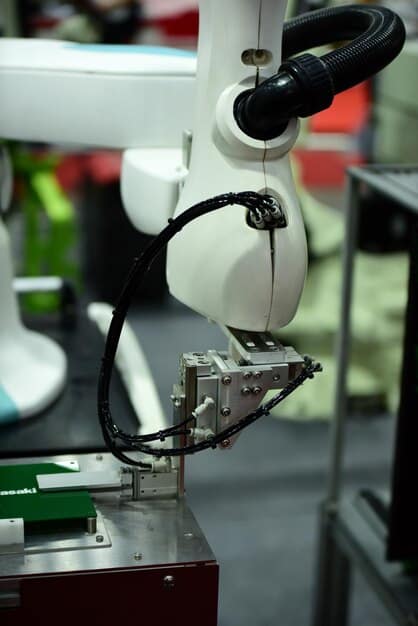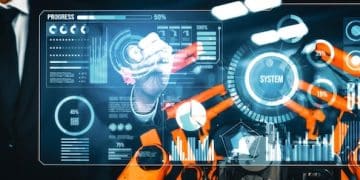Automation’s Impact on US Jobs: Opportunities & Challenges for Businesses

Automation is significantly reshaping the US job market, presenting businesses with both opportunities for increased efficiency and challenges in workforce adaptation.
The rise of automation is transforming industries across the United States, prompting both excitement and apprehension. Understanding the impact of automation on the US job market: opportunities and challenges for businesses is crucial for navigating this evolving landscape and ensuring sustainable growth.
Understanding Automation’s Influence on the US Job Market
Automation is no longer a futuristic concept; it’s a present-day reality reshaping the dynamics of the US job market. Businesses are increasingly adopting automated technologies to streamline operations, reduce costs, and enhance productivity. This technological shift brings about both promising opportunities and significant challenges that require careful consideration.
Defining Automation in the Modern Workplace
Automation refers to the use of technology to perform tasks with minimal human assistance. This can range from simple rule-based processes to complex decision-making activities. Understanding the scope of automation is crucial for assessing its impact on different sectors.
The Scope of Automation Across Industries
Various industries are experiencing the transformative effects of automation. Manufacturing, logistics, healthcare, and finance are just a few examples where automated systems are becoming increasingly prevalent. Each sector faces unique implications based on the nature of its tasks and workforce.

- Increased efficiency and productivity.
- Reduced operational costs.
- Improved accuracy and consistency.
- Enhanced safety in hazardous environments.
Automation is not merely about replacing human labor. It is about re-imagining work processes to achieve optimal performance. Businesses must strategically integrate automation to maximize its benefits while also addressing potential disruptions to the workforce.
The Opportunities Automation Presents for Businesses
The adoption of automation technologies opens up a plethora of opportunities for businesses in the US. From boosting productivity to driving innovation, automation can be a game-changer for companies looking to thrive in today’s competitive landscape. Understanding these opportunities is essential for making informed investment decisions.
Boosting Productivity and Efficiency
One of the primary benefits of automation is its ability to significantly enhance productivity and efficiency. Automated systems can perform tasks faster and more consistently than humans, leading to higher output and reduced error rates.
Reducing Operational Costs
While the initial investment in automation can be substantial, the long-term cost savings can be significant. Automated systems reduce the need for manual labor, lower energy consumption, and minimize waste, resulting in substantial operational cost reductions.
Driving Innovation and New Business Models
Automation empowers businesses to explore new avenues for innovation and develop novel business models. By automating routine tasks, employees can focus on more creative and strategic activities, driving innovation and fostering a culture of continuous improvement.
- Increased efficiency and productivity.
- Reduced operational costs.
- Improved product quality and consistency.
- Enhanced ability to scale operations quickly.
Automation provides businesses with a competitive edge by enabling them to deliver higher-quality products and services at a lower cost. This competitive advantage can lead to increased market share and improved profitability.
The Challenges Automation Poses to the US Job Market
While automation offers numerous advantages, it also presents significant challenges to the US job market. Addressing these challenges is crucial for ensuring a smooth transition and mitigating potential negative impacts on workers and communities.
Job Displacement and Workforce Transition
One of the most significant concerns associated with automation is the potential for job displacement. As automated systems take over routine tasks, some workers may find their jobs at risk. Facilitating workforce transition through training and education is essential for helping displaced workers find new opportunities.
Skills Gap and the Need for Upskilling
Automation is changing the skills required for many jobs. As routine tasks become automated, there is a growing demand for workers with advanced technical and problem-solving skills. Businesses need to invest in upskilling and reskilling programs to ensure their workforce can adapt to these changing demands.
Ethical Considerations and Social Impact
The widespread adoption of automation raises important ethical considerations and social impact issues. Businesses need to consider the potential consequences of automation on workers and communities, and take steps to mitigate any negative impacts.

- Job displacement and workforce transition.
- Skills gap and the need for upskilling and reskilling.
- Ethical considerations and social impact.
- Increased income inequality.
Addressing the challenges posed by automation requires a collaborative effort between businesses, government, and educational institutions. By working together, these stakeholders can ensure that the benefits of automation are shared broadly.
Strategies for Businesses to Navigate the Automation Landscape
To thrive in the age of automation, businesses must adopt proactive strategies that leverage the opportunities while mitigating the challenges. These strategies include investing in workforce development, embracing human-machine collaboration, and fostering a culture of innovation.
Investing in Workforce Development and Training
One of the most critical strategies for businesses is to invest in workforce development and training programs. These programs should focus on equipping workers with the skills they need to operate and maintain automated systems, as well as to perform higher-level tasks that cannot be automated.
Embracing Human-Machine Collaboration
Rather than viewing automation as a replacement for human labor, businesses should embrace human-machine collaboration. By combining the strengths of humans and machines, businesses can achieve optimal performance and create new opportunities for workers.
Fostering a Culture of Innovation and Adaptability
To thrive in the age of automation, businesses need to foster a culture of innovation and adaptability. This includes encouraging employees to experiment with new technologies, embracing new ideas, and adapting to changing market conditions.
- Investing in workforce development and training.
- Embracing human-machine collaboration.
- Fostering a culture of innovation and adaptability.
- Prioritizing ethical considerations and social impact.
By adopting these strategies, businesses can navigate the automation landscape successfully and create a more resilient and equitable workforce.
The Role of Government and Policy in Managing Automation’s Impact
Government and policy play a crucial role in managing the impact of automation on the US job market. Policymakers need to develop strategies that support workforce transition, promote education and training, and address the ethical and social implications of automation.
Supporting Workforce Transition and Retraining Programs
Government can play a critical role in supporting workforce transition by providing funding for retraining programs and job placement services. These programs can help displaced workers acquire the skills they need to find new opportunities in emerging industries.
Promoting Education and Skills Development
Investing in education and skills development is essential for ensuring that the US workforce can compete in the age of automation. Government can promote education by providing funding for STEM programs and supporting initiatives that encourage lifelong learning.
Addressing Ethical and Social Implications
Policymakers need to address the ethical and social implications of automation by developing regulations that protect workers’ rights, promote fair labor practices, and ensure that the benefits of automation are shared broadly.
Government and policy can play a significant role in shaping the future of work. By working together with businesses and educational institutions, policymakers can ensure that the US workforce is prepared for the challenges and opportunities of automation.
Future Trends in Automation and the Job Market
The future of automation and the job market is likely to be characterized by continued technological advancements, evolving workforce dynamics, and the emergence of new industries and job roles. Staying informed about these trends is crucial for businesses and workers alike.
Continued Technological Advancements
Automation technologies are likely to continue to evolve at a rapid pace. Artificial intelligence, machine learning, and robotics are just a few examples of the technologies that are expected to drive further automation in the years to come.
Evolving Workforce Dynamics
The workforce is likely to become more diverse and flexible as automation continues to reshape the job market. Workers will need to be adaptable and willing to learn new skills throughout their careers.
Emergence of New Industries and Job Roles
Automation is expected to create new industries and job roles that do not exist today. These new opportunities will require workers with advanced technical and problem-solving skills.
By staying informed about these future trends, businesses and workers can prepare for the changes ahead and position themselves for success in the age of automation.
| Key Point | Brief Description |
|---|---|
| 💡 Increased Efficiency | Automation boosts productivity with faster, consistent task completion. |
| ⚙️ Skills Gap | Demand for technical skills rises; workers need upskilling and retraining. |
| 💼 Job Displacement | Some jobs are at risk, necessitating workforce transition support. |
| 🌱 Innovation | Automation fosters new business models and innovation opportunities. |
Frequently Asked Questions
▼
Automation involves using technology to perform tasks with minimal human intervention. For businesses, it often leads to increased efficiency, reduced operational costs, and improved accuracy, but also requires workforce adaptation.
▼
The primary benefits include enhanced productivity, lower costs, improved product quality, and a greater ability to scale operations. It allows businesses to achieve more with fewer resources, enhancing competitiveness.
▼
Automation can lead to job displacement in certain sectors as machines take over manual tasks. However, it also creates new job opportunities in areas like AI maintenance, data analysis, and system management.
▼
Critical skills include technical proficiency, data analysis, problem-solving, and adaptability. These skills enable workers to manage and interact with automated systems effectively and to take on more strategic roles.
▼
The government should support workforce transition with retraining programs, promote STEM education, and establish regulations that protect workers’ rights, ensuring a fair and equitable distribution of automation benefits.
Conclusion
In conclusion, the impact of automation on the US job market: opportunities and challenges for businesses is a multifaceted issue that requires careful planning and strategic adaptation. By embracing automation thoughtfully and investing in workforce development, businesses can harness its potential while mitigating its risks. This proactive approach will be key to fostering a resilient and competitive economy in the years to come.





